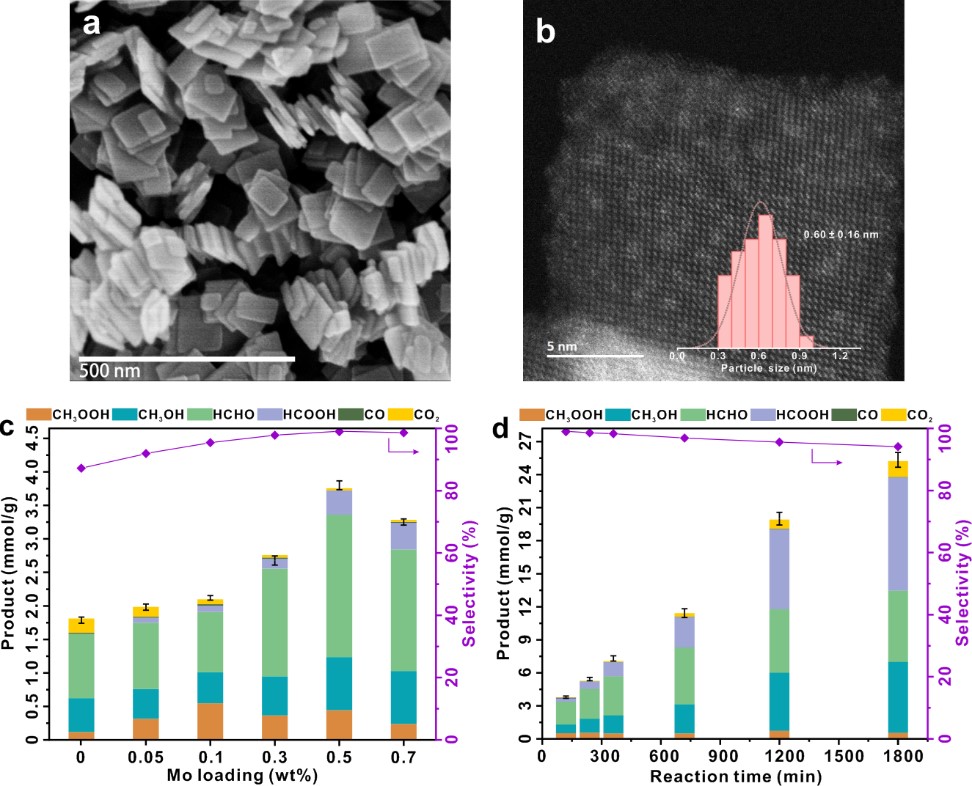
Researchers from the Innovation Academy for Precision Measurement Science and Technology (APM) of the Chinese Academy of Sciences has discovered that anchoring subnanometric MoOx clusters onto TiO2 nanosheets can effectively suppress the formation of CO2 during methane oxidation, significantly enhancing the selectivity for oxygenated organic products, shedding light on the activity and mechanism of photocatalytic selective oxidation of methane.
The findings were published in Nature Communications.
Methane (CH4), abundant but chemically inert, presents challenges for direct conversion into high-value products like methanol and formaldehyde. Traditional thermocatalytic methods require harsh conditions and often suffer from low selectivity, leading to over-oxidation. Photocatalysis, driven by solar energy, offers a greener alternative but improving both activity and selectivity remains difficult. While noble metal cocatalysts such as gold improve performance, their high cost limits practical application. Hence, non-noble metal promoters like nickel and cobalt have garnered interest, yet balancing conversion rate and selectivity remains elusive.
In this study, the researchers developed a TiO2-based photocatalyst decorated with ultrasmall (0.6 nm) MoOx clusters. They achieved an efficient photocatalytic oxidation reaction of methane. The catalyst with a 0.5% MoOx loading exhibited the optimal catalytic activity, achieving an organic oxygenate yield of 3.8 mmol/g within two hours, with selectivity approaching nearly 100%. It exhibited an apparent quantum yield of 13.3% at 365 nm and maintained stable high selectivity (>95%) over 1,800 minutes of continuous reaction, demonstrating excellent durability.
In situ Electron Paramagnetic Resonance (EPR) and Nuclear Magnetic Resonance (NMR) analyses revealed that MoOx clusters activate O2 to form surface-active species (Mo−OO and Mo−OOH), which facilitate the activation of methane's carbon-hydrogen bonds to form reaction intermediates (Mo-CH2). This effectively inhibits the formation of hydroxyl radicals (•OH) and superoxide radicals (O2•−), thereby reducing the over-oxidation of products .
Moreover, photogenerated electrons reduce Mo species that, in the presence of water, facilitate formaldehyde desorption from the catalyst surface, preventing further oxidation.
This study provides new insights for designing efficient non-noble metal catalysts, advancing the practical application of methane conversion technology.
This work was supported by the National Natural Science Foundation of China and the Chinese Academy of Sciences.

a. SEM image of TiO2; b, ACHAADF-STEM image of 0.5MoOx-TiO2; c. Photocatalytic activity and selectivity for methane oxidation over catalysts with different Mo loadings; d. Photocatalytic activity and selectivity for methane oxidation over the 0.5MoOx-TiO2 catalyst with extended reaction time. (Image by APM)

a. EPR experiment for radical trapping, with DMPO as the trapping agent; b. In-situ solid-state NMR experiments on 0.5MoOx-TiO2 and TiO2 catalysts under different illumination times; c. Reaction mechanism diagram. (Image by APM)

86-10-68597521 (day)
86-10-68597289 (night)

52 Sanlihe Rd., Xicheng District,
Beijing, China (100864)

